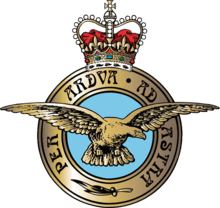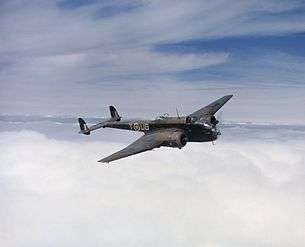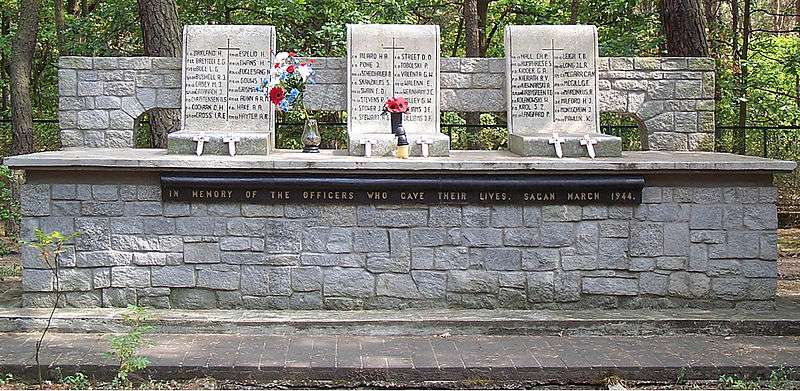Brian Evans (RAF officer)
| Brian Herbert Evans | |
|---|---|
 | |
| Birth name | Brian Herbert Evans |
| Born |
14 February 1920 Shaldon, Devon |
| Died |
31 March 1944 (aged 24) between Görlitz and Sagan |
| Buried | Poznan Old Garrison Cemetery, Poland |
| Allegiance |
|
| Service/ |
|
| Years of service | 1939–44 |
| Rank | Flight Lieutenant |
| Service number | 42745 |
| Unit | No. 49 Squadron RAF |
| Battles/wars | |
| Awards | |
Brian Herbert Evans (14 February 1920 – 31 March 1944), was a Royal Air Force bomber pilot who was taken prisoner during the Second World War. Notable for his part in the 'Great Escape' from Stalag Luft III in March 1944 he was one of the men recaptured and subsequently murdered by the Gestapo.
Pre-war life
Evans was born in Shaldon, Devon the son of Australian born Dorothy and Captain Herbert Evans (Mercantile Marine) Clan Line steamers.[1] It is noted that German records state that he was born in "Shelton" (sic).[2] The family later moved to Upton near Birkenhead which was near to the port regularly used by Clan Line steamers. In 1933 Alan Cobham’s air circus set up very close to their home and young Brian fell in love with aircraft and flying. In the summer of 1935 the family moved to Cardiff.[3] Although desperate to get into civil aviation Evans struggled with mathematics and it blocked his progress. He left school in 1938 and moved to Liverpool to work in wholesale grocery and then back to Cardiff as an apprentice in a firm of auctioneers and surveyors.[4] He joined Cardiff Aeroplane Club and gained his civil pilots license No. 17016 on 7 February 1939 flying a De Havilland DH.60[5]
Wartime Service
Evans joined the Royal Air Force with effect from 8 August 1939 and was posted to the Civil Flying School at Gatwick. He was granted a short service commission (4 years) as acting pilot officer on 9 October 1939[6] By April 1940 he was flying with No. 14 Operational Training Unit at RAF Cottesmore making anti-submarine patrols in Avro Anson aircraft and on 4 May 1940 he was confirmed as pilot officer[7][8] On 30 September 1940 he was posted to No. 49 Squadron RAF at Scampton flying Handley Page Hampdens but was severely wounded on 16 October 1940 by anti-aircraft fire over Bordeaux harbour flying Hampden L4129 on a mine laying mission. Evans managed to get the damaged bomber home and crash landed at Lenham, Kent at 0450 hours; three of the crew survived alive but one died.[9][10][11] Returning to operational flying in November,he suffered a second crash.[10]

Prisoner of war
Flying as second pilot with an experienced crew Evans took part in a night attack on German airfields in Northern France on 6 December 1940. Handley Page Hampden serial number P4404 (squadron codes EA-R) received anti-aircraft damaged and then ran into a snowstorm over Paris where both engines iced up and failed, the aircraft had to be crash landed in a field near Courville, Marne where all but one airman was injured. The local farmer agreed to help the crew but then sent a boy to get the Germans.[12][13] German records show that he was taken prisoner on 7 December 1940 and became prisoner of war number 456. He arrived at prison camp Stalag Luft I Barth[2] where on 4 May 1941 he was promoted flying officer[14] and was later moved to Stalag Luft III in the province of Lower Silesia near the town of Sagan (now Żagań in Poland).[15] On 4 May 1942 Evans was promoted flight lieutenant [16]
'Great Escape'
For the Great Escape operation Evans was a regular tunneller and earned a favourable early position in the line of the two hundred men hoping to escape through the tunnel. As such he was one of the 76 men who escaped the prison camp on the night of 24–25 March 1944, in the escape now famous as "the Great Escape". When the Germans discovered the escape they began extensive well planned manhunts which resulted in the recapture of officers relatively quickly.[17] Evans is reported to have been recaptured near Halbau[18][19] The recaptured officers were collected at Görlitz prison under Gestapo control. Here the numbers of recaptured officers grew until thirty-five were held there, the prisoners were threatened with death and interrogated harshly but not physically.[20] On 30 March 1944 two of the survivors saw three large sedans with ten Gestapo agents collect six officers who were taken away. On the next day ten more recaptured officers were taken away by Gestapo agents, they included Brian Evans, these men were not seen alive again.[18][20][21]
The bodies of this group were cremated at Liegnitz by the Gestapo.[19][22] He was one of the 50 escapers executed and murdered by the Gestapo.[19][23][24][25] Originally cremated and buried at Sagan, he is now buried in part of the Poznan Old Garrison Cemetery.[26][27]
His name was amongst the 47 murdered officers named in the British press when the story became public knowledge on or about 19–20 May 1944[28] The Glasgow Herald of 19 May 1944 published an early list naming several officers including Evans[29]

Awards
His conspicuous bravery was recognized by a Mention in Despatches as none of the other relevant decorations then available could be awarded posthumously. It was published in a supplement to the London Gazette on 8 June 1944.[30]
Other victims
The Gestapo executed a group of 50 of the recaptured prisoners representing almost all of the nationalities involved in the escape.
Post-war investigations saw a number of those guilty of the murders tracked down, arrested and tried for their crimes.[31][32][33]
| Nationalities of the 50 executed |
References
- Notes
- ↑ Vance (2000), p.19
- 1 2 Andrews (1976), photo page, copy German records
- ↑ Vance, Jonathan F (2000). A Gallant Company: The Men of the Great Escape. Pacifica Military History. p. 19. ISBN 978-0-935-55347-5.
- ↑ Vance (2000), p.20)
- ↑ Ancestry, Royal Aero Club Certificates 1910-50-Brian Herbert Evans]
- ↑ "No. 34718". The London Gazette (Supplement). 27 October 1939. pp. 7179–7180.
- ↑ "No. 34780". The London Gazette (Supplement). 11 June 1940. pp. 3518–3519.
- ↑ "No. 34976". The London Gazette (Supplement). 22 October 1940. pp. 6138–6139.
- ↑ Chorley (1992), p.119
- 1 2 Vance (2000), p.20
- ↑ Moyle (1989), p.93
- ↑ Chorley (1992), p.136
- ↑ Moyle (1989), p.115
- ↑ "No. 35183". The London Gazette. 6 June 1941. pp. 3231–3232.
- ↑ Vance (2000), p.21)
- ↑ "No. 35643". The London Gazette (Supplement). 21 July 1942. pp. 3240–3241.
- ↑ Andrews (1976), p.55
- 1 2 Vance (2000), p.240-241
- 1 2 3 Andrews (1976), p.205
- 1 2 Andrews (1976), p.49
- ↑ Read (2012), p.222
- ↑ Burgess (1990), p.172-173
- ↑ Read (2012), p.244 and p.304
- ↑ Burgess (1990), p.271
- ↑ Vance (2000), p.289
- ↑ Reading Room Manchester. "War Graves Commission casualty – Brian Herbert Evans". cwgc.org. Retrieved 2015-08-29.
- ↑ "Archive - 50 murdered escapers". pegasusarchive.org. Retrieved 2015-08-29.
- ↑ Western Morning News, Dundee Courier and Yorkshire Post, 20 May 1944
- ↑ [Glasgow Herald page on line - article naming officers]
- ↑ "No. 36544". The London Gazette (Supplement). 2 June 1944. pp. 2619–2620.
- ↑ Read (2012), p.295
- ↑ Vance (2000), p.310
- ↑ Andrews (1976), p.188 and 199
- Bibliography
- Ted Barris (2014). The Great Escape. Dundurn Publishing. ISBN 1459728440.
- Simon Read (2012). Human Game. Constable. ISBN 978-1-4721-1262-0.
- Sean Feast (2015). The Last of the 39-ers. Grub Street. ISBN 978-1909166158.
- Jonathan F Vance (2000). A Gallant Company. Pacifica Military. ISBN 978-0-935-55347-5.
- Moyle, Harry (1989). The Hampden File. Air Britain. ISBN 0-85130-128-2.
- Chris Goss (1997). Bloody Biscay. Crecy. ISBN 0-947554874.
- William Ash; Brendan Foley (2005). Under the Wire: The Wartime Memoir of a Spitfire Pilot, Legendary Escape Artist and 'cooler King'. Bantam. ISBN 978-0-593-05408-6.
- Paul Brickhill (2004). The Great Escape. W.W. Norton & Company. ISBN 978-0-393-32579-9.
- Alan Burgess (1990). The Longest Tunnel: The True Story of World War II's Great Escape. Naval Institute Press. ISBN 978-1-59114-097-9.
- Albert P. Clark (2005). 33 Months as a POW in Stalag Luft III: A World War II Airman Tells His Story. Fulcrum Pub. ISBN 978-1-55591-536-0.
- Arthur A. Durand (1989). Stalag Luft III: The Secret Story. Patrick Stephens Limited. ISBN 978-1-85260-248-2.
- William R Chorley (1992). RAF Bomber Command Losses, Volume 1. Midland Counties. ISBN 0904597857.
- Allen Andrews (1976). Exemplary Justice. Harrap. ISBN 0-245-52775-3.
External links
- Project Lessons from the Great Escape (Stalag Luft III), by Mark Kozak-Holland. The prisoners formally structured their work as a project. This book analyses their efforts using modern project management methods.